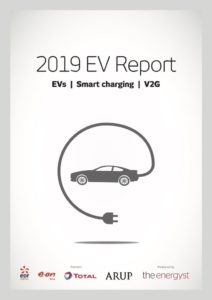 The tipping point is coming, say electric vehicle (EV) charging point companies, fossil majors and would-be disruptors building charging networks.
The tipping point is coming, say electric vehicle (EV) charging point companies, fossil majors and would-be disruptors building charging networks.
“Within five years, EV charging will be like wifi; a hygiene factor that you have to offer or customers will be unhappy,” says Erik Fairbairn, CEO & founder, Pod Point.
Supermarkets and other retail and destination sites are mobilising. Tesco has struck a deal with Pod Point and Volkswagen to install 2,400 EV charging bays across 600 stores over the next three years, the biggest UK rollout of its type to date. Some will be free-to-use 7kW units, others 50kW rapid chargers, which shoppers will pay to use.
As Tesco’s competitors start to respond, Fairbairn says, “it will move the market”.
“I would be unsurprised if in six month’s time we see a deal of another order of magnitude. Corporates with customer car parks understand EVs are something they have to deal with now – not in a few years,” says Fairbairn. “It is a megatrend.”
Legal & General shares that view. It has acquired a 13 per cent stake in Pod Point – giving the firm both significant expansion capital and boosting its development pipeline: Legal & General plans to install charging points across its estate and new homes portfolio.
Driving profit
 Tom Callow, director of communications and strategy at BP Chargemaster, agrees and says destination charging drives both footfall and spend.
Tom Callow, director of communications and strategy at BP Chargemaster, agrees and says destination charging drives both footfall and spend.
“Our data shows drivers are going into those sites and spending money,” he says, providing a breakdown via email:
• The majority of drivers who charged at these locations did so more than once a month, creating regular footfall
• The majority of drivers who charged at the locations – up to 84% for one type of location – spent money there
• For one type of location, more than 1 in 4 drivers were not members of the relevant loyalty scheme, suggesting they may not otherwise have visited the site
• Presence of charging points made a visit to these sites more likely for 95% of drivers.
Forecourt models
BP, which bought Chargemaster in 2018, has some 1,200 UK forecourts (300 owned and operated and over 900 owned and operated by dealers) and is commencing a rollout of 150kW superfast chargers.
“Forecourts are designed for a quick turnaround so the 150kW units fit that profile nicely,” says Callow. “Rapid and ultra rapid chargers will take up an increasing proportion of our network.”
Yet even with that amount of power – where cars can take such speeds – a full charge still takes around 20 minutes. That could present challenges to forecourt operators and motorists alike. But Callow thinks it may be an opportunity.
“Most people don’t fill up a fuel tank from full to empty, they tend to top up with 20-30 litres. With electric cars, we will see a similar top-up culture,” he says.
“An efficient EV does around 4 miles per kilowatt hour. If you can offer 100 miles of range in ten minutes, it is not that much longer than current fuel courts,” suggests Callow.
“Okay, topping up the tank takes two minutes, but by the time you have queued and paid, it is not a million miles away.”
Moreover, drivers do not need to attend electric cars while they are charging – so they can buy a coffee or other goods and services on offer. Callow says this is where BP’s experience with retailers such as M&S will help “make all of that fit together”.
BP Chargemaster will begin its 150kW forecourts rollout “as soon as possible this year”, says Callow. But he stresses that ‘rollout’ is the operative word.
“This is not a trial, but a network rollout. Others are talking about dipping toes in the water; BP is definitely going for a swim.”
Power struggles
Securing megawatts of capacity for forecourts will be neither easy nor cheap. “The power piece will be a challenge,” admits Callow. He says obtaining distribution network connections and capacity can occasionally become “like a game of battleships” with DNOs.
Everyone deploying significant numbers of chargers therefore needs to find “creative ways” of managing capacity challenges, he adds, with BP Chargemaster no exception.
What about connecting directly to the transmission network?
“That is outside my business unit,” says Callow. But he does not rule it out: “It’s safe to say all businesses in this area are looking at all options on the table rather than a single avenue.”
Transmission pivot
 Pivot Power is connecting 49.9MW batteries directly to the transmission system with a view to delivering grid services – and later, EV charging.
Pivot Power is connecting 49.9MW batteries directly to the transmission system with a view to delivering grid services – and later, EV charging.
The firm hopes to work with chargepoint operators – and thinks they may ultimately come to Pivot. Chief operating officer, Matthew Boulton, says its transmission-connected approach “is unblocking a problem they will face”.
“It is not just about securing the 1-2MW they will need for 10-15 fast chargers, but future proofing. In five to 10 years the utilisation rates will reach a level of demand that no DNO can provide for today, because they cannot promise reserve capacity.”
Boulton says the “dream” scenario would be to turn some of the 45 sites Pivot is planning into “EV flagship sites” with showrooms and rentals, alongside other retail.
He also believes Pivot’s city edge sites could prove interesting to fleet operators and transport providers. Boulton thinks bus companies “could be massive” for Pivot.
Home is where the grid is
Capacity constraints may lead some transport companies to set up around the grid, rather than trying to bring the grid to their existing depots. Boulton says the company is in “very early” discussions with one bus company about that.
“Its depot is split across two leased sites without long-term commitments,” says Boulton. “But I think we will find other scenarios where the depot is close to the city centre and not within reach of our city edge substation. Town real estate has considerable development value, does it make commercial sense to move further out?”
In some cases, Boulton thinks that may be the only way Pivot can provide power for depots. “We’re not proposing to take a 33kV cable through a city centre,” he says.
See more on Pivot’s latest project in Oxford here.
Electric buses-as-a-service
 With cities establishing low emission zones, bus companies are under pressure to switch their fleets to alternative fuels. Their challenge is cost and complexity, says Daniel Saunders, investment director at Octopus Investments. The company thinks it can solve that by offering electric buses-as-a-service.
With cities establishing low emission zones, bus companies are under pressure to switch their fleets to alternative fuels. Their challenge is cost and complexity, says Daniel Saunders, investment director at Octopus Investments. The company thinks it can solve that by offering electric buses-as-a-service.
“For bus operators firstly the buses are very expensive and secondly they have to invest in their depots, which probably means they must also invest in the local grid,” he says.
While depot investments can sit on balance sheets, grid upgrades do not, making an investment harder to justify to shareholders. Saunders thinks that makes a pay-per-mile approach attractive.
“They stay in control and choose the buses they want to run. We package that together with the infrastructure and they pay off the investment as they use the vehicles.”
Saunders agrees with Pivot’s Matthew Boulton that some operators may choose to move closer to grid infrastructure than pay for upgrades.
“That is not always straightforward, but if that is what they want to do, we will support it,” he says. “We are coming at this with no restrictions.”
Solar+storage+EV forecourts
 Gridserve has unveiled plans to build 100 Electric Forecourts. CEO Toddington Harper says Gridserve has 80 sites in various stages of planning. The aim is to build 20 forecourts within the next two years and over 100 within five – each with retail, services and restaurants – and EV showrooms or ‘experience hubs’.
Gridserve has unveiled plans to build 100 Electric Forecourts. CEO Toddington Harper says Gridserve has 80 sites in various stages of planning. The aim is to build 20 forecourts within the next two years and over 100 within five – each with retail, services and restaurants – and EV showrooms or ‘experience hubs’.
Where possible, the firm will deploy megawatts of solar and storage at each site – as it is doing in York and Hull via a £62m deal with Warrington Council. Construction at the first of those projects, a 34.7MWp solar farm and 27MW battery storage system at York, is now underway.
Harper says the sites will have optimised queuing systems to avoid charge rage. “You don’t want to get that wrong.”
There will be up to 12 super chargers “capable of 500kW per charger” as well as up to 12 spaces for fleet and commercial vehicles per site. With a “well-organised queuing system”, the company’s modelling suggests drivers will typically be waiting “for a few minutes, which is acceptable”, Harper says.
 This article was written for The Energyst’s new 2019 EV Report, which is available here as a free download.
This article was written for The Energyst’s new 2019 EV Report, which is available here as a free download.
The report contains a survey of public and private sector organisations on their plans to deploy charging infrastructure, how they plan to fund it, whether they have sufficient capacity etc. It also contains interviews with energy and technology companies, distribution network operators and consultants, as well as case study interviews with businesses rolling out charging infrastructure and switching fleets to EVs.
The report also includes interviews with sponsors Arup, EDF Energy, Eon and Total Gas & Power.
Download the free report here.
Related stories:
Free electric vehicles and charging infrastructure report
Vehicle-to-grid: Are we nearly there yet?
EVs: How UPS is driving down emissions
Oxford goes large on EVs, hybrid storage and heat pumps
Superchargers: Why the chicken crossed the road
WPD outlines EV numbers it can handle, connections and upgrade costs
EVs: Car parks sought for V2G trials
Nissan: 2019 will be “breakthrough year” for V2G, eyes energy retail market
Volkswagen: Carmaker to become energy company
Pubs and supermarkets the new petrol stations?
Chargepoint raises £189m to fund EV charging infrastructure
BT and Eon pledge to electrify fleet by 2030
Total partners with Chargepoint to bundle energy and EVs to businesses
Octopus backs flex and EVs for growth
Energy managers to become fleet managers
EV boom no sweat, says National Grid
Flexitricity chief: UK has enough spare power electrify every car on the road
Pivot makes huge play for 2GW storage and EV charging network
‘Land grab’ for EV car parks and revenue
National Grid predicts huge solar growth, while EVs create huge storage capacity
Follow us at @EnergystMedia. For regular bulletins, sign up for the free newsletter.



